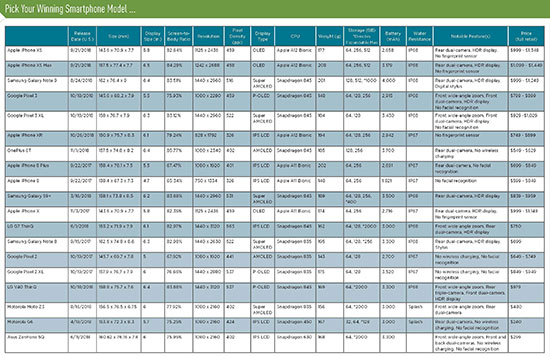
This is the fifth annual State Bar of Wisconsin summary of the best currently available smartphones. As is the case every year, the options and features continue to improve and expand. Enhancements to camera quality, display quality, processing power, and battery life were common among all manufacturers and models. Whether you’re on team iPhone or team Android, there are amazing phones to consider on the high end of the pricing scale as well as those for the more budget-conscious consumers.
Speaking of the debate between iPhone and Android, most experts recommend sticking with what you know, rather than making a switch. If you are used to the more customizable experience of Android, you might find iOS restrictive and frustrating. If you like the user experience and frequent updates of iOS, you may find Android customization options overwhelming. Apps are increasingly made for both operating systems. One difference lawyers may be particularly interested in is that more malware is written for Android than iOS. Some Android phones allow for storage expansion.
After several years using one operating system, I made the switch myself in March 2018. In my experience, the experts are correct. I am glad I tried something else, and there were definitely advantages in the other operating system, but I probably should have stuck with the system I was accustomed to. I will be switching back with my next smartphone.
Wireless phone service providers continue to offer smartphones for purchase with monthly payments at zero-interest financing over two to three years or for the full price at the outset. Monthly payments of $10-60 seem more palatable than $240-1,100 all at once.
As usual, service coverage will depend on where you primarily spend your time and travel. If you tend to stay in your community, a regional carrier with lower service costs may suit your needs. At the other end of the spectrum, regular international travelers will need to be aware not only of service but also of the hardware capabilities of the phone itself. Larger service providers tend to offer a wider array of manufacturers and models, but you may be able to buy a particular model from another retailer and still use it on your network, even if they don’t sell that model directly. Check with the service provider to be sure.
Some manufacturers are missing from this year’s list. The reviews of HTC and Sony smartphones just weren’t as good this year, and phones from Chinese manufacturers such as Huawei and Xiaomi are not sold by major service providers in the United States, mainly because of security concerns. This article focuses on the most common smartphone manufacturers and models provided by the networks used in Wisconsin.
Changes for 2019
Camera features, photo quality, and photography software seem to be most often touted by smartphone reviews. Expert photographers will want to dive deeper into the specifications than this article does, but for the masses, there are a lot of fun, new offerings.
 Aly Lynch, Marquette 2007, chairs the State Bar of Wisconsin Law Office Management Assistance Program Advisory Committee. She has a master’s of professional studies in law firm management and is vice president of special projects for the Wisconsin Chapter of the Association of Legal Administrators. She worked in law firm management for eight years and is now a freelance executive assistant, website developer, and nonprofit organization coordinator.
Aly Lynch, Marquette 2007, chairs the State Bar of Wisconsin Law Office Management Assistance Program Advisory Committee. She has a master’s of professional studies in law firm management and is vice president of special projects for the Wisconsin Chapter of the Association of Legal Administrators. She worked in law firm management for eight years and is now a freelance executive assistant, website developer, and nonprofit organization coordinator.
Only three phones on this list have a single camera on both front and back. They all have at least a 12MP camera on the back and 7MP on the front. The Asus ZenFone 5Q has dual cameras on the front and the back, and the LG V40 ThinQ has a total of five cameras. With that many cameras, even the selfie options are seemingly endless. Amazing photo-editing software capabilities allow even dabbling photographers to spend hours playing with the possibilities and finding go-to settings that make their pictures awesome. If camera quality is important to you, look for a small aperture number (F1.8 or smaller) rather than worrying about megapixels.
Processors continue to increase speed and improve the overall smartphone experience. The iPhones went from the Apple A11 CPU last year to the Apple A12, and nearly all the Androids on this list have the Snapdragon 845. These phones have better computing power than most laptops today.
Smartphone batteries continue to improve as well. Non-iPhones tend to have longer battery life, but even the iPhones will get you through a day of normal use without a need to charge.
Screen sizes have increased compared to last year’s models. Most of the new models are over six inches. Fortunately, there are a variety of accessories available to help you hold that big phone with one hand.
The two major smartphone display types are AMOLED and IPS LCD. They each have advantages and disadvantages, and the differences between the two have changed over the years and will continue to change. Major manufacturers put their own proprietary technologies in their displays, so two different AMOLED smartphone displays, for example, may not look the same. AMOLED is generally better than LCD, but most people will find these displays are all amazing and will be better than the phone you bought two years ago. (See the individual phone descriptions, below, for details about display.)
Phones are rated by IP Code, or international protection marking, to indicate the degree of protection provided against dust and water. Most of this year’s phones are rated IP 67 and IP 68. The first digit indicates the level of solid particle protection, with 6 being the most protection, and the second digit indicates liquid protection. A phone rated IP67 can be immersed in up to 1 meter of fresh water for up to 30 minutes and a phone rated IP68 can be immersed in 1.5 meters of fresh water for up to 30 minutes.
OnePlus decided the IP rating was not worth the extra cost that would be passed on to customers for the 6T, but it claims the 6T can survive an accidental water dunk. It is possible the extra cost is the reason a few others on this list lack that IP rating.
Smartphones started ditching the traditional 3.5mm headphone jack a few years ago. While some models still have this jack, the iPhones continue to use their proprietary lightning connector, and many of the Androids use the USB-C type of connector. Non-3.5mm jack phones provide a converter so you can still use your traditional headphones or hook up to Bluetooth for wireless headphones.
The majority of phones on this year’s list have facial recognition. Nearly all the phones have fingerprint scanners, except iPhones X and newer. The Samsung phones on this list also have iris scanners, which are the most accurate biometrics. Even identical twins have different iris patterns. You can still use a passcode or pattern to unlock the phone, log in to protected apps, and pay for purchases. So if you are nervous about the security of using biometrics for these activities, you can disable them.
For a side-by-side comparison of some of the main specs on the latest smartphones, see the accompanying table below. Click on the image to view a larger version.

The Field: Pricey
Apple iPhone XS ($999 - 1,349) and XS Max ($1,049 - 1,449)
The iPhone XS and XS Max are the best smartphones you can buy today. They have fantastic cameras and photo software, rich color displays, all-day batteries, and super-fast processors. They are the best iPhones ever made. They are also the most expensive phones available. They do not come with quick-charging or wireless-charging accessories, but those can be purchased separately. The XS Max has the largest screen of the phones on this list (6.5 inches) and has a bigger battery than the XS.
Buy one of these phones if you want the best iPhone.
Samsung Galaxy Note 9 ($999 - 1,249)
The Samsung Galaxy Note 9 has a very good camera, top hardware, and an amazing display. The new S Pen digital stylus works as a remote in addition to having traditional handwriting and drawing abilities. Samsung’s AI assistant, Bixby, is a work in progress compared to Apple’s Siri and Google Assistant, but Google Assistant can be used on Samsung phones as well. The Note 9 allows for one terabyte of storage, if you have the 512GB version and add a 512GB microSD card. This phone has a 3.5mm headphone jack.
Buy this phone if you want the best Android, the best battery life, and the most storage and will appreciate the digital stylus.
Google Pixel 3 ($799 - 899) and 3 XL ($929 - 1,029)
The Google Pixel 3 and 3 XL have great hardware, best-in-class cameras, dual front-facing speakers, and rich color display. These phones are great for streaming, and the battery is good unless you are taking photos all day. The Pixel 3 Lite has not been officially announced, but reports say it will be similar to the iPhone XR with a smaller display. The 3 XL is significantly larger and has better resolution than the 3, but the 3 is among the lightest phones on this list.
Buy this phone if you want the phone with the best camera or just one of the best Androids, generally.
Samsung Galaxy S9 Plus ($839 - 959)
The Samsung Galaxy S9 Plus is a very well-built phone. It has an excellent camera and stereo speakers. The battery could be better, but it should still last all day. The S9 Plus is slightly smaller and cheaper than the Note 9 and has no stylus. The display is amazing and even better than the iPhone XS. This is Samsung’s answer to the iPhone X, so it has facial recognition and AR emojis. This phone has a 3.5mm headphone jack.
Buy this phone if you want a great Samsung but do not want the stylus or you want the best display.
LG V40 ThinQ ($979)
The LG V40 is the first smartphone with five cameras. It has three rear cameras for regular, super-wide-angle, and 2x optical zoom photography. Two front-facing cameras allow you to take standard and super-wide-angle selfies. This is not a bad phone; it has all the features and hardware of other high-end Androids, but it is not nearly as highly ranked as the other most expensive phones. You can expand the storage in the V40 to 2TB.
Buy this phone if you want the only phone with five cameras.
The Field: Mid-Range Budget
Apple iPhone XR ($749 - 899)
The iPhone XR is the most affordable and recently released new iPhone. It has a great battery life; the battery will last all day with normal use. It comes in several colors. The screen resolution is lower and the camera could be better, but it still has the powerful internal hardware and performance of the more expensive smartphones. It is, however, a fairly expensive smartphone.
Buy this phone if you want a new iPhone but cannot bring yourself to spend more than $1,000 on it.
OnePlus 6T ($549 - 629)
The OnePlus 6T is a top-tier quality smartphone at a generic price. It is incredibly fast, looks great, has a big screen (6.4 inches) and the largest screen-to-body ratio, and is built very well. It has cameras with 16 and 20MP on the back and another 16MP camera on the front, making it one of the smartphones with the highest resolution cameras. As mentioned above, it is not IP rated to be waterproof, but the company says it can survive an accidental drop into water.
This is the first OnePlus phone to work on a mainstream network (Verizon). It does not have wireless charging, there is no headphone jack, and the screen resolution and pixel density are less than many of the other phones on this list, but if you want to spend less than $600 on a top smartphone, you must expect to do without some features.
Buy this phone if you want the least expensive top-rated smartphone and don’t mind a lesser-known brand.
LG G7 ThinQ ($750)
The LG G7 is a great smartphone with a super-bright display with excellent resolution and pixel density as well as a larger screen-to-body ratio. The cameras are fantastic with dual 16MP on the back and F1.6 and F1.9 aperture, as well as front wide-angle zoom for selfies. You can expand the storage in the G7 to 2TB. This phone has a 3.5mm headphone jack.
Buy this phone if you want a great LG phone or want a less expensive phone with an excellent camera.
The Field: Frugal
Motorola Moto Z3 ($480) and G6 ($240)
The Moto Z3 and the G6 are good smartphones. They just aren’t as good as the others on this list. As you would expect from smartphones this inexpensive, the screen resolution and display are not as good. The cheaper G6 doesn’t have wireless-charging capabilities or facial recognition and runs on an older processor, but it has a 3.5mm headphone jack. These are among the lightest phones on the list. You can expand the storage in the Z3 to 2TB.
Buy these phones if you like Motorola phones or want a good phone for under $500 or even under $250.
Asus ZenFone 5Q ($299)
The ZenFone 5Q is another super-cheap (relatively speaking) smartphone. It has two 16MP cameras on the back and two 20MP cameras on the front, making it one of only two phones on this list with 20MP cameras. As with the Motorola phones, the ZenFone 5Q resolution and display are not as good as those of other phones on this list. It does have a better processor than the Moto G6. You can expand the storage to 2TB. This phone has a 3.5mm headphone jack.
Buy this phone if you want a low-budget phone with high-resolution, dual cameras in the front and back.
Last Year’s Top Models
Just because a phone came out in 2017 does not mean it’s obsolete. Phones like the iPhone 8, 8 Plus, and X, the Google Pixel 2 and 2 XL, and the Samsung Galaxy Note 8 are still really good phones and, with reduced prices, remain competitive. Many reviews still put these phones in the top 20 smartphones now available.
Wrap Up
Overall, the iPhone XS and XS Max, the Samsung Galaxy Note 9, and the Google Pixel 3 and 3 XL are arguably the “best” smartphones currently available, but that doesn’t necessarily mean they are the best for you. If you prefer specific features, functionality, or specifications, you’ll want to investigate further to find some of the additional options. For most people, though, and based on the reviews of present users and experts, these are the best smartphones currently available. And unless you’re very particular about your gadgets, having a nice, new, fast phone is always exciting.
